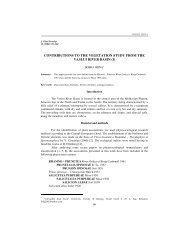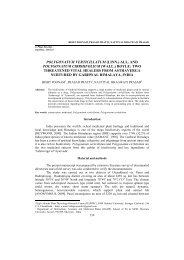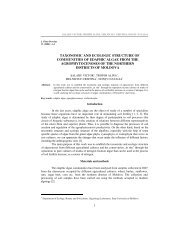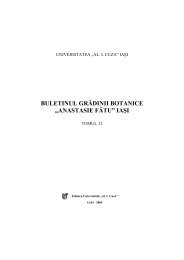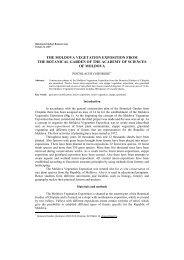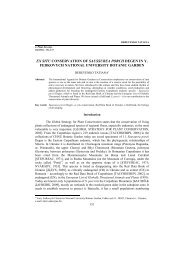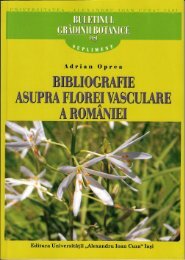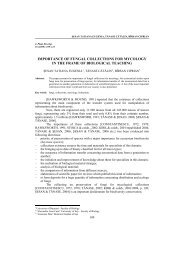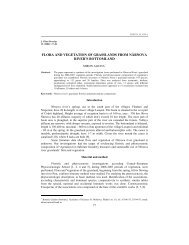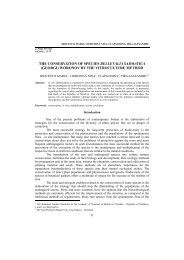Buletinul Grădinii Botanice Iaşi - Journal of Plant Development
Buletinul Grădinii Botanice Iaşi - Journal of Plant Development
Buletinul Grădinii Botanice Iaşi - Journal of Plant Development
You also want an ePaper? Increase the reach of your titles
YUMPU automatically turns print PDFs into web optimized ePapers that Google loves.
<strong>Buletinul</strong> <strong>Grădinii</strong> <strong>Botanice</strong> <strong>Iaşi</strong><br />
Tomul 14, 2007<br />
PLANTS FROM THE HABITAT DIRECTIVE – ANNEX IIb,<br />
PRESENTS IN ROMANIA<br />
SÂRBU ANCA ∗ , OPREA ADRIAN ∗∗ , SÂRBU ION ∗∗<br />
Summary: In order to assist the Romanian Government in fulfilling their obligations required to become a full<br />
member <strong>of</strong> the European Union, the Dutch Agency for International Business and Cooperation<br />
(EVD) developed a special project, focused on Habitat Directive plants, having as result a<br />
preinventory for a draft list <strong>of</strong> Natura 2000 sites (SCIs) for plant species. In this frame the<br />
Romanian botanists evaluated the existing lack <strong>of</strong> information concerning the plants distribution in<br />
Romania, the difference between national and internal approach and the requirements for well<br />
understand and document this group <strong>of</strong> taxa, very important for Habitat Directive implementation<br />
in Romania.<br />
Key words: Romanian accession agreement, threatened plants, lack <strong>of</strong> information, up-date database<br />
Introduction<br />
The objective <strong>of</strong> this paper was to realize an overview on the existing information<br />
about the plant species from the Habitat Directive 92/43/EEC, present in Romania and<br />
nominated in the Accession Agreement <strong>of</strong> Romania to the European Union, including a<br />
clear discussion on the arrised problems and gaps, results and future needs [5].<br />
This contribution is a result <strong>of</strong> the project “The implementation <strong>of</strong> the EU Nature<br />
Conservation legislation in Romania” developed in the framework <strong>of</strong> the PSO Pre-<br />
Accession programme (PPA) and financial supported by the Netherlands.<br />
Methodology<br />
The present overview used as working background international and national<br />
relevant documents and scientific reference publications, as:<br />
- Habitat Directive 92/43/EEC<br />
- The list <strong>of</strong> the plant taxa from Habitat Directive (Annex IIb) presents in Romania<br />
and nominated in the Accession agreement <strong>of</strong> Romania to the European Union<br />
- Council Directive 92/43/EEC <strong>of</strong> 21 st <strong>of</strong> May 1992 on the conservation <strong>of</strong> natural<br />
habitats and <strong>of</strong> wild fauna and flora<br />
- The Romanian law no. 422/2001 (with all the modification and up-dating)<br />
- The Romanian Flora (vol. 1-13) (1952-1976) [7]<br />
- The flora <strong>of</strong> Romanian Pteridophyta and Spermatophyta [2]<br />
- The Romanian Red List <strong>of</strong> vascular plants [3]<br />
- The Critical list <strong>of</strong> vascular plants from Romania [4]<br />
- Important <strong>Plant</strong> Areas in central and eastern Europe [1]<br />
- Important areas for plants in Romania [5]<br />
∗<br />
University <strong>of</strong> Bucharest, Faculty <strong>of</strong> Biology, Department <strong>of</strong> Botany, Aleea Portocalelor 1-3, Sector 6, Bucureşti,<br />
e-mail: agbr_sarbu@yahoo.com<br />
∗∗<br />
Botanical Garden “Anastasie Fătu” <strong>Iaşi</strong>, str. Dumbrava Rosie, nr. 7-9, 700487 Iasi; e-mail: aoprea@uaic.ro
24<br />
- Special areas for plant conservation in Romania [Sârbu et al., 2007]<br />
The existing information about those 50 plant taxa included in the Accession<br />
Agreement <strong>of</strong> Romania to the European Union was evaluated from the following point <strong>of</strong><br />
views: distribution on the Romanian territory (location from the literature and location<br />
confirmed in the last 5 years), information about the populations state (unknown, poor,<br />
medium, good), conservation state (globally threatened, european threatened, national<br />
conservation value), distribution maps, photos with plants and their habitats and existing<br />
gaps in knowledges.<br />
Results and discussions<br />
From the whole amount <strong>of</strong> plants listed in Annex IIb <strong>of</strong> the Habitat Directive<br />
92/43/EEC, are still present in Romania 50 species and subspecies (47 vascular plants and 3<br />
briophytes): 8 taxa are globally threatened and 40 taxa are European threatened (Table 1).<br />
Taxa<br />
(Annex IIb)<br />
Tab. 1. <strong>Plant</strong> for the Habitat Directive – on overview on the existing<br />
information in Romania<br />
Number<br />
<strong>of</strong><br />
locations<br />
from the<br />
literature<br />
Number <strong>of</strong><br />
locations<br />
confirmed<br />
in the last<br />
5 years<br />
Information about the population state Conservation state<br />
unknown<br />
poor medium good Globally<br />
threatened<br />
European<br />
threatened<br />
National<br />
statute<br />
1. Adenophora lilifolia<br />
(L.) Ledeb. ex A.DC.<br />
22 6 -<br />
2. Agrimonia pilosa<br />
Ledeb.<br />
18 6 R<br />
3. Aldrovanda vesiculosa<br />
L.<br />
44 5 EN<br />
4. Angelica palustris<br />
(Besser) H<strong>of</strong>fm.<br />
18 5 VU/R<br />
5. Apium repens (Jacq.)<br />
Lag. – uncertain<br />
presence<br />
3 - EX<br />
6. Asplenium<br />
adulterinum Milde<br />
8 4 B, R<br />
7. Astragalus peterfii<br />
Jáv.<br />
3 1 A, EN/R<br />
8. Caldesia parnassifolia<br />
(L.) Parl.<br />
13 1 VU/R<br />
9. Campanula romanica<br />
Săvul.<br />
29 9 A, VU/R<br />
10. Campanula serrata<br />
(Kit.) Hendrych<br />
44 49 -<br />
11. Centaurea jankae<br />
D.Brândză<br />
6 3 A, EN<br />
12. Centaurea pontica<br />
Prodan & Nyár.<br />
2 3 A, EN<br />
13. Cirsium<br />
brachycephalum<br />
Juratzka<br />
15 - B, VU/R<br />
14. Colchicum arenarium<br />
Waldst. & Kit<br />
3 2 B, EN/R<br />
15. Crambe tataria<br />
Sebeók<br />
29 12 VU/R<br />
16. Cypripedium<br />
calceolus L.<br />
41 19 V/R<br />
17. Dianthus diutinus<br />
Kit. – uncertain<br />
presence<br />
1 - B, EX<br />
18. Draba dorneri Heuff. 6 3 A, VU/R<br />
19. Dracocephalum<br />
austriacum L.<br />
4 2 R<br />
20. Echium russicum<br />
J.F.Gmel.<br />
22 27 -<br />
21. Eleocharis carniolica<br />
Koch<br />
39 6 -<br />
22. Ferula sadleriana<br />
Ledeb.<br />
2 1 VU/R
23. Galium moldavicum<br />
(Dobrescu) Franco<br />
3 2 b, VU/R<br />
24. Gladiolus palustris<br />
Gaud.<br />
4 1 ?<br />
25. Himantoglossum<br />
hircinum ssp.<br />
caprinum (Bieb.) V.<br />
Koch<br />
38 7 R<br />
26. Iris aphylla L. ssp.<br />
hungarica Hegi<br />
49 5 -<br />
27. Iris humilis Georgi<br />
ssp. arenaria (Waldst.<br />
& Kit.) A. & D. Love<br />
9 3 VU/R<br />
28. Ligularia sibirica (L.)<br />
Cass.<br />
57 19 R<br />
29. Liparis loeselii (L.)<br />
Rich.<br />
20 9 R<br />
30. Luronium natans (L.)<br />
Raf. – uncertain<br />
presence<br />
2 - EX<br />
31. Marsilea quadrifolia<br />
L.<br />
42 7 VU<br />
32. Moehringia jankae<br />
Griseb. ex Janka<br />
8 4 b, R<br />
33. Paeonia <strong>of</strong>ficinalis L.<br />
ssp. banatica (Rochel)<br />
Soó<br />
5 1 b, R<br />
34. Poa granitica Braun–<br />
Blanq. ssp. disparilis<br />
(Nyár.) Nyár.<br />
25 4 A, R<br />
35. Potentilla emilii-popii<br />
Nyár.<br />
9 8 b, VU/R<br />
36. Pulsatilla patens (L.)<br />
Mill.<br />
21 3 R<br />
37. Pulsatilla pratensis<br />
(L.) Mill. ssp.<br />
hungarica Soó<br />
15 1 -<br />
38. Pulsatilla vulgaris ssp.<br />
grandis Wenderoth<br />
35 7 R<br />
39. Salicornia veneta<br />
Pignatti & Lausi<br />
7 1 R<br />
40. Saxifraga hirculus L. 5 1 VU/R<br />
41. Serratula lycopifolia<br />
(Vill.) A.Kern.<br />
17 3 VU/R<br />
42. Stipa danubialis<br />
Dihoru & Roman<br />
4 1 A, R<br />
43. Syringa josikaea<br />
Jacq.f.<br />
14 2 b, VU/R<br />
44. Thesium ebracteatum<br />
Hayne – uncertain<br />
presence<br />
3 - EX<br />
45. Thlaspi jankae<br />
A.Kern.<br />
5 3 b, R<br />
46. Tozzia carpathica<br />
Woł. (Tozzia alpina L.<br />
ssp. carpathica (Woł.)<br />
Dostál)<br />
33 23 R<br />
47. Tulipa hungarica<br />
Borbás<br />
9 3 R<br />
48. Drepanocladus<br />
vernicosus (Mitt.)<br />
Varnst.<br />
6 6 -<br />
49. Meesia longiseta<br />
Hedw.<br />
4 5 -<br />
50. Sphagnum pylaisii<br />
Brid.<br />
1 - -<br />
Globally threatened (G) – (IUCN Red List + Habitat Directive – Annex IIb & IVb + Bern Convention – App I)<br />
European threatened (EN) - (Habitat Directive – Annex IIb & IVb + Bern Convention – App I)<br />
National statute (N) – according the “Romanian Red List”, 1994 (Oltean & colab.): EX – extinct, A – endemic, R<br />
– Rare, b – near endemic, VU – vulnerable, EN – threatened, B – European areal, ? – without information.<br />
In aldine letter – the taxa included under the Habitat Directive 92/43/EEC, as a result <strong>of</strong> Romania and Bulgaria<br />
accession to the EU.<br />
25
26<br />
Crambe tataria Sebeók<br />
Family name: Brassicaceae<br />
Short description:<br />
Vascular, perennial, herbaceous plant.<br />
Xeromezophyte.<br />
Long root about 120 cm length.<br />
Hairly and branched stalked about 60-100 cm<br />
length.<br />
Big basal leaves, rhomb-shaped, 2-3<br />
pinnately-sected with long leaf-stalk.<br />
Short petiolate, pinnately-lobed stalk leaves.<br />
Compact racemous, umbel-like inflorescence.<br />
Flowers with white corolla about 5-6 mm<br />
length and 3 mm wide. Silicule about 5-7 mm<br />
length.<br />
<strong>Plant</strong>s growing in grassy and sunny hills.<br />
Habitat type: Grasslands<br />
Regions <strong>of</strong> occurrence in Romania:<br />
Continental, Pannonic, Steppic, Black Sea<br />
(bio-geographical regions)<br />
Status in Romania (Romanian Red List):<br />
Vulnerable/Rare<br />
Relevance for EU: high (European<br />
threatened)<br />
Occurrence in Romania:<br />
- Location from literature: 29 sites<br />
- Up-date information (5 years): 12 sites<br />
Distribution map – actual recent occurrence:<br />
1. Dealul cu Fluturi 7. Pădurea şi Pajiştile de la Mârzeşti<br />
2. Fânaţele Clujului – Copârşaie 8. Rezervaţia de bujori de stepă Zau de Câmpie<br />
3. Fânaţele Clujului – Valea lui Craiu 9. Rezervaţia Naturală “Fânaţele Glodeni”<br />
4. Fânaţele de pe Dealul Corhan – Săbed 10.Rezervaţia Naturală “Ponoare” – Bosanci<br />
5. Pâcle Sud – Vulcanii Noroioşi 11. Rezervaţia Naturală “Frumoasa” – Moara<br />
6. Pădurea Parc “Gârboavele” 12. Rezervaţia Naturală “Valea lui David”<br />
Gaps in knowledge:<br />
- location, size <strong>of</strong> populations, rank in Romania, photos<br />
- 35% <strong>of</strong> the information on the location is older than 30 years<br />
References sources (selection):<br />
- Sârbu A., Sârbu I., Oprea A., Negrean G. Cristea V., Coldea G., Cristurean I., Popescu G. Oroian S.,<br />
Baz A., Tănase C., Bartok K., Gafta D., Anastasiu P., Crişan F., Costache I., Goia I., Maruşca Th.,<br />
Oţel V., Sămărghiţan M., Henţea S., Pascale G., Răduţoiu D., Boruz V., Puşcaş M., Hiriţiu M., Stan I.,<br />
Frink J., 2007, Arii speciale pentru protecţia şi conservarea plantelor în România, Edit. Victor B<br />
Victor, Bucureşti, pp: 397.<br />
- Săvulescu Tr. (coord. pp.), 1952-1976, Flora R.P.R. – R.S.R., I-XIII, Edit. Acad. Române<br />
- Morariu I., 1965, Rezervaţia de la Bosanci, Ocr. nat., 9, nr. 1: 72-76.<br />
- Mititelu D., colab., 1993, Contribuţii noi la cunoaşterea florei şi vegetaţiei judeţului Bacău, St. Com.<br />
Muz. Şt. Nat. Bacău, /1980-1993/: 81-108.<br />
- Ciocârlan V., 1970, Contribuţii la flora României, St. cerc. Biol., Ser. Bot., 22, 5: 371-381 + 7 fig.<br />
- Mititelu D., colab., 1981, O nouă contribuţie la flora rezervaţiei botanice de la “Frumoasa-Moară”<br />
(Jud. Suceava), Stud. Com. Ocr. Nat., Suceava, 5: 394-395.<br />
Fig. 1 Crambe tataria – Existing information and gaps in knowledges
The existing informations about these plants, nominated in the Accession<br />
Agreement <strong>of</strong> Romania to the European Union show many gaps in knowledge, especially<br />
with regard to their location, maps <strong>of</strong> distribution and populations state. For those 50<br />
nominated taxa, 876 locations were identified from the botanic literature. Some <strong>of</strong> them<br />
have very large areas as Carpathian mountains or all the Romanian regions (Maramureş,<br />
Transilvania, Crişana, Banat, Oltenia, Muntenia, Moldova, Bucovina & Dobrogea).<br />
Unfortunately, we have up-date information for only about 220 populations, belonging to<br />
38 taxa. For the other populations only the information from literature was available and<br />
this information is, in different proportions, older than 30 years. Four taxa nominated in the<br />
literature as present in Romania (e.g. Apium repens, Dianthus diutinus, Luronium natans<br />
and Thesium ebracteatum) have an uncertain presence in Romania.<br />
In order to better underline the existing lack on information an example (Crambe<br />
tararia) has been presented in Fig. 1.<br />
Conclusions<br />
• The existing information about the 50 plants taxa from the Habitat Directive<br />
92/43/EEC – Annex IIb is incomplete, not full up-date and breaked-up. Consequently<br />
it’s not in accordance with the European requirements.<br />
• A special programme needs to be developed in order to establish an up-date database<br />
on the Romanian plant taxa, nominated in the Habitat Directive – Annex IIb. The field<br />
activity made by botanists and phytocoenologists is required as a basic source <strong>of</strong><br />
information. Without this type <strong>of</strong> activity the information will be not up-date, and the<br />
existing old, incomplete and an very general information will be continuous used.<br />
References<br />
1. ANDERSON S. (coord.), 2005 – Important <strong>Plant</strong> Areas in Central and Eastern Europe, Publishing House<br />
<strong>Plant</strong>life, Anglia, 103 pp.<br />
2. CIOCÂRLAN V., 2000 – Flora ilustrată a României. Pteridophya et Spermatophyta, Edit. Ceres, Bucureşti:<br />
1138 pp.<br />
3. OLTEAN M., NEGREAN G., POPESCU A., ROMAN N., DIHORU GH., SANDA V., MIHĂILESCU S.,<br />
1994 – Lista roşie a plantelor superioare din Romania, În Oltean M. (coord.) – Stud., Sint., Docum.<br />
Ecol., Edit. Acad. Române, Inst. de Biologie, Bucureşti, 1: 1-52.<br />
4. OPREA A., 2005 – Lista critică a plantelor vasculare din România, Edit. Univ. „Alexandru Ioan Cuza”,<br />
<strong>Iaşi</strong>, 668 pp.<br />
5. SÂRBU A., 2006 – Important areas for plants in Romania, Edit. Bureau Waardenburg bv – Consultants for<br />
Environment & Ecology, The Netherlands, 254 pp.<br />
6. SÂRBU A., SÂRBU I., OPREA A., NEGREAN G., CRISTEA V., COLDEA G., CRISTUREAN I.,<br />
POPESCU G., OROIAN S., BAZ A., TĂNASE C., BARTOK K., GAFTA D., ANASTASIU P.,<br />
CRIŞAN F., COSTACHE I., GOIA I., MARUŞCA Th., OŢEL V., SĂMĂRGHIŢAN M., HENŢEA S.,<br />
PASCALE G., RĂDUŢOIU D., BORUZ V., PUŞCAŞ M., HIRIŢIU M., STAN I., FRINK J., 2007,<br />
Arii speciale pentru protecţia şi conservarea plantelor în România, Edit. Victor B Victor, Bucureşti,<br />
397 pp.<br />
7. SĂVULESCU TR. (coord. pp.), 1952-1976, Flora R.P.R. – R.S.R., I-XIII, Edit. Acad. Române, Bucureşti.<br />
27



